Green Schools are Vegan Schools
Vegan schools are more environmentally friendly.
When all the evidence is added up, it no longer makes sense to serve meat and dairy products in schools, whether in school lunch programs, during pizza fundraisers, or with hot dogs at Fun Day. Meat and dairy at school are no longer cool because the livestock industry contributes to global warming and climate change. The only way to be a truly green — and compassionate — school community is to "go veg"!

Our task must be to free ourselves ... by widening our circle of compassion to embrace all living creatures and the whole of nature and its beauty.... Nothing will benefit human health and increase chances of survival for life on Earth as much as the evolution to a vegetarian diet.
— Albert Einstein
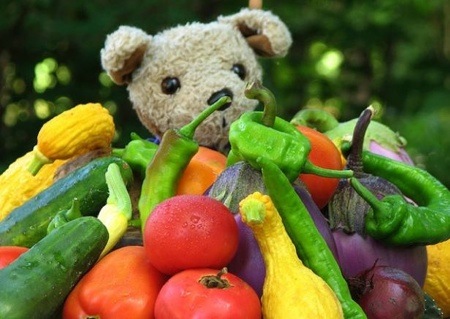
Photo by -Snugg- used with permission
Why Vegan Schools?
The evidence is clear that eating meat and dairy products increases the risk of health problems such as obesity, heart disease, high blood pressure, cancers, diabetes, food poisoning, and more — and not just in adults. If we care about the children, our students, we must be willing to consider the evidence, and do something.
There is also a connection between meat eating and world hunger, violence and inhumaneness. (See The World Peace Diet and anything by John Robbins for more info.)
And now, more and more, we are coming to see that the industrialized livestock industry, in North America certainly and around the world as well, is a huge contributor to environmental problems such as
- land use changes and deforestation, leading to land degradation (erosion, desertification, release of carbon from soils) and
biodiversity loss
- water pollution (from run-off) and water scarcity
- air pollution and acid rain (from emissions of carbon monoxide, chlorofluorocarbons, ammonia, oxides of nitrogen, sulphur dioxide, and volatile organic compounds or VOCs)
- nitrogen pollution (which leads to decreased forest productivity in surrounding areas)
- the greenhouse gas emissions that are leading to global warming and climate change (methane from animals and their manure, nitrogen from the production of nitrogen fertilizers for feedcrops, CO2 from processing plants and the transport of livestock and products)
One easy way to ensure that schools are not responsible for contributing to poorer health, world hunger, violence and environmental degradation is simply to not serve meat and other livestock-related foods at school functions and for school lunches. Vegan schools are more socially and environmentally responsible.
This is not to say that schools should start policing what comes to school in students' lunches — far from that. (Although there is definitely an opportunity here for nutrition education and environmental education for parents!)
Many families, when they hear about the impacts of livestock production on climate change, are willing to at least reduce their meat and dairy consumption if not go completely vegan (no animal products at all) or vegetarian (dairy and eggs, but no meat) — for the sake of their own health and their children's future.
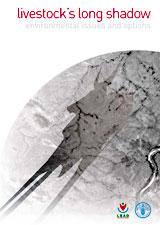
At virtually each step of the livestock production process, substances contributing to climate change or air pollution are emitted into the atmosphere, or their sequestration in other reservoirs is hampered. Such changes are either the direct effect of livestock rearing or indirect contributions from other steps on the long road that ends with the marketed animal product....
Livestock activities emit considerable amounts of these three gases [carbon dioxide, methane, nitrous oxides — all potent greenhouse gases]....
Globally, livestock are the most important source of anthropogenic methane emissions…. and account for 35-40 percent of global anthropogenic emissions. Ruminants, and to a minor extent also monogastrics, emit methane as part of their digestive process, which involves microbial fermentation of fibrous feeds. Animal manure also emits gases such as methane, nitrous oxides, ammonia and carbon dioxide, depending on the way they are produced (solid, liquid) and managed (collection, storage, spreading).
Livestock also affect the carbon balance of land used for pasture or feedcrops, and thus indirectly contribute to releasing large amounts of carbon into the atmosphere. The same happens when forest is cleared for pastures. In addition, greenhouse gases are emitted from fossil fuel used in the production process, from feed production to processing and marketing of livestock products.
— Livestock's Long Shadow: Environmental Issues and Options, United Nations Food and Agriculture Organization
Foods for Vegan Schools
Special Event Foods for Vegan Schools
- hot dogs can be veggie dogs
- pizza can be vegan cheese pizza with all sorts of vegetable and fruit toppings
- Chinese food can be veggie spring rolls and vegetable chop suey with bits of marinated tofu over noodles or rice
- lasagna can be vegetable lasagna or vegan cheese lasagna
- Mexican can be bean burritos with vegan nacho salad and a mild salsa
- nachos can be made with hummus and salsa
- sandwiches can be made from nut butters (if allowed in your school), or seitan, tempeh, or TVP (textured vegetable protein) or soy crumble with a healthy vegan "cheese sauce" (or see this list of 50 vegan sandwiches)
- hamburgers can be veggie burgers
- school garden harvest "potluck" buffet
Always try to find organic ingredients, for the health of your students and the Earth.
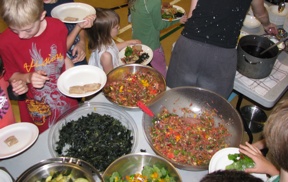
Check out my school's Harvest Potluck luncheon.
The offerings were vegetarian (mostly vegan), fresh from the school garden (except for the veggie dips), and cooked/baked by the students with help from their teachers or parent volunteers.
Rainbow coleslaw, kale chips, green salad, beet borscht, baked potato wedges, zucchini lasagna and zucchini bread, fava bean dip with pita bread made from the wheat my class grew at the community garden. Perhaps the presentation wasn't the most beautiful, but it was delicious and the kids loved it!
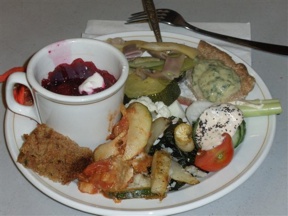
Lunch Menus for Vegan Schools
Did you know that the average family has only nine favourite meals? I'll bet that school cafeterias don't have many more than that (many school food programs start repeating their menus after just a week or two), so it's a fairly simple task to "veganize" a family's diet or a school's lunch menus. As examples, here are my family's nine favourite dinners (I follow a gluten-free diet, so adding wheat products will make this list even easier to add to):
- Chili "sans carne" (without meat) (add grated carrots, artichoke hearts, textured vegetable protein (TVP, a soy product), and a mix of colourful beans; serve with vegan cornbread)
- Stuffed peppers (rice with lots of different veggies and tofu)
- Black beans on rice or quinoa (add crushed pineapple for zing)
- Pasta (with vegan pesto or marinara sauce; add veggie ground round or TVP for a "meatier" sauce)
- Sunday "roast" (potatoes, onions, garlic, carrots, beets, broccoli, kale and other veggies surrounding marinated tofu or veggie pâté, or served with soy cutlets)
- Ratatouille over rice, couscous or quinoa (the quintessential harvest stew of zucchini, eggplant, peppers, onions, garlic, tomatoes and herbs like oregano, basil or thyme)
- Perogies with fried onions and soy bacon bits (with soy-based sour cream or plain soy yogurt, if you're a diehard)
- Asian noodles with bean sprouts and ginger coconut soy sauce
- Veggie burgers
- Stirfry with loads of veggies and tofu
- Greek salad (which is yummy even without the feta cheese) and spanakopita, or stuffed grape leaves (which can be vegan)
- Mashed potato pie (one of George Bernard Shaw's favourites)
- Curried vegetables (make it mild and everyone will love it) over rice, with lentil dal
Okay, that's more than nine! But it makes the point. It is NOT difficult to make the switch to vegan meals at school. Try this with your own family's favourite meals.
If your local school offers a breakfast and/or lunch program, check out the menus. It's great to see more schools (and some whole school systems)
- eliminating chocolate milk
- purchasing locally grown produce
- offering whole grain breads and cereals
- reducing added sugar and salt
- increasing dried bean options and fibre rich foods
- labelling foods for different ethnic and religious groups, and
- offering vegetarian and even, in some jurisdictions, vegan options
but think how much easier and healthier (and cheaper, if not for meat subsidies and "commodities bonuses" in the USA) school lunch programs would be if they offered only the vegan option and became vegan schools. Why offer unhealthy hamburgers and cheeseburgers when you're offering nutritious veggie burgers anyway? Why offer spaghetti with meat sauce when you're serving spaghetti with marinara sauce anyway?
And why have we gotten into the habit of providing so much choice at lunchtime? (In our society, choice = waste.) Even keeping religious, spiritual and allergy needs in mind, it is still possible to serve delicious vegan school lunches every day and meet everyone's needs.

A Letter to Jamie Oliver — Let's Veganize the Food Revolution!
Dear Jamie,
You rock! You're doing great work to revolutionize what people in developed countries are eating. I know you're a chef who's been trained to cook what people want, and I know you're not a vegetarian, but would you consider making your signature piece for your Food Revolution series a vegan one?
That way, you would not only be contributing to increased health and nutrition for everyone, but you would be helping in the struggle to safeguard the future of your children and my grandchildren from global warming and climate disruption.
It's now widely known that industrialized livestock, especially in North America, is one of the greatest producers of greenhouse gases in the world, so encouraging and modelling a transition to a more plant-based diet and vegan schools (without necessarily even bringing attention to it) would be one of the best contributions you can make with your program.
Thanks for considering this.
GreenHeart Education
p.s. Please put a garden in the schoolyard of every school you work with!
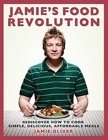
Jamie Oliver keeps campaigning for healthier food — and especially, healthier food in schools. And now it seems we've convinced him to, you know, go veg (at least part-time) and endorse healthy vegan diets. I wonder if he'll help create vegan schools as well! For the sake of kids' current health, as well as their future health, well-being and climate safety.
Resources for Vegan Schools
If you are willing to help your school, school district and parent advisory group go veg, here are some resources to assist you.
Physicians Committee for Responsible Medicine's Healthy School Food Resource Section (with some excellent educational and promotional materials for veg schools)
World Watch Institute's Livestock and Climate Change
The Vegetarian Resource Group's Tips for Introducing Vegetarian Food into Institutions (American focus, but lots of menu suggestions)
What's for Lunch? Schools Bring Vegetarian Options to the Table by Juliann Schaeffer in the April 2008 issue of Today's Dietitian
Forks Over Knives, a documentary feature-length film that examines the scientific research behind the claim that most, if not all, of the degenerative diseases that afflict our society (heart disease, cancer, diabetes) can be controlled, or even reversed, by rejecting animal-based and processed foods, and choosing a plant-based diet
SMTV, the international TV channel of a humanitarian spiritual group that provides subtitled programming on the connection between diet and environment (including vegan cooking shows)
The World Peace Diet is a must-read for anyone who wants to understand the historical and cultural connection between a diet based on the oppression of other animals and an economy based on the destruction of the rest of Nature
A Compilation of Quotations for Veg Schools [ready-to-print pdf, compliments of GreenHeart Education]

Lifelong eating patterns are established in childhood. Thus, getting vegetarian meals into schools will do more than satisfy the very important goal of providing a warm vegan or vegetarian lunch to your children and their friends. Including veggie alternatives at lunchtime affirms that vegetarian meals are healthy, bona fide and desirable; an understanding that will affect students' dietary choices throughout their lifetime.
This means future adults will indeed eat more plant-based meals and encourage their children to do the same; a simple dietary change that provides multiple benefits. A minimal 10% reduction in the amount of meat consumed across America will save the lives of approximately 900,000,000 animals per year, free enough grain to feed 60 million people, and greatly reduce environmental pollution.
— Susan Wieland, in The Time is Right for Getting Veggie Meals into Schools... And Here's How YOU Can Do It! at VegFamily.com.
If you eat meat, I can imagine that you might be feeling a bit conflicted or threatened after reading this page. It's said that we are what we eat, and therefore we tend to strongly defend and rationalize our own diet. Please know that I was vegetarian for nearly 30 years before I ever asked anyone else to consider giving up meat. That's because the climate change crisis has changed everything. (I'm now vegan.)
We must now be acting on every possible way to lower our greenhouse gas emissions, and eating lower on the food chain is the easiest step we — as individuals, as families, as schools — can take. (In many developed countries, it's certainly easier than giving up our cars.)
Besides, nobody ever died from eating nutritionally balanced vegan lunches at school!
Seriously, the request here is not necessarily to "go vegan" yourself (although that would be a real gift), but to refrain from serving animal products at school for the sake of our students.
Creating vegan schools means we are working to
safeguard the future — one meal at a time.

Return from Vegan Schools to Greening School Behaviour
Return to GreenHeart Education Homepage






